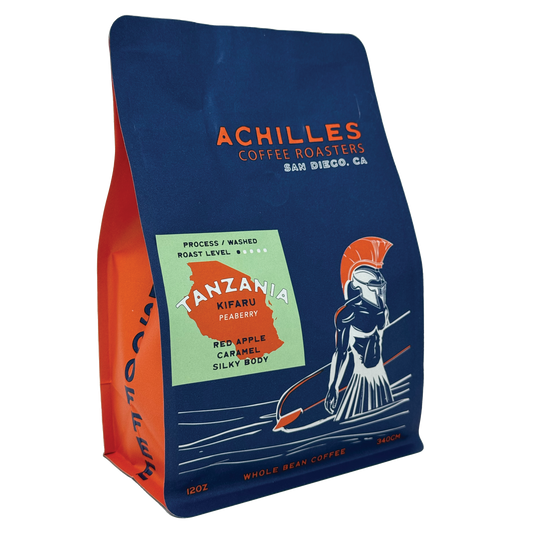Coffee is one of the most chemically complex beverages in the world, with over 800 aromatic compounds contributing to its flavor and aroma. These compounds are responsible for the wide spectrum of tasting notes you might encounter—from bright, citrusy, and floral nuances to deeper tones of chocolate, nuts, spices, or even wine-like qualities. The diversity of coffee’s flavor isn’t random; it’s the result of a fascinating interplay between nature and environment.
While roasting curves and brewing methods certainly refine and shape what you taste in the cup, the foundation of coffee’s character is established long before it reaches a roaster. Two of the most influential forces in this early stage are altitude and terroir. Together, they define how coffee plants grow, how cherries ripen, and ultimately, how beans develop the sugars, acids, and aromatic compounds that dictate their final profile.
Altitude directly affects bean density and sugar development, with higher elevations producing slower-growing cherries that concentrate more complexity. Terroir, a term borrowed from the wine industry, encompasses everything from soil composition and rainfall to microclimates and sun exposure. These factors combine to give each coffee a “sense of place” that shines through in the cup.
This is why an Ethiopian coffee might burst with jasmine and blueberry notes while a Brazilian coffee leans toward chocolate, nuts, and caramel. It’s also why certain coffees are prized for their lively acidity and fruit-forward brightness, while others are cherished for their mellow smoothness and comforting richness. By understanding how altitude and terroir shape flavor, you gain a deeper appreciation for the journey of your coffee—from the soil and climate where it’s grown to the complex sensory experience it delivers in your cup.
What Is Terroir in Coffee?
Borrowed from the wine industry, terroir describes the distinctive set of environmental conditions that influence how coffee is grown and how it ultimately tastes in the cup. Far from being a single factor, terroir is a combination of climate, soil, altitude, and sunlight exposure, all of which work together to shape the growth of the coffee plant and the development of its cherries.
Climate – Temperature, rainfall, and seasonality all play critical roles in determining how quickly or slowly coffee cherries ripen. A stable, moderate climate with distinct wet and dry seasons tends to produce beans with more consistent and balanced flavors.
Soil composition – The nutrients, drainage, and organic matter in the soil provide the building blocks for coffee plants. Volcanic soils, for example, are often associated with complex and vibrant coffees because they are rich in minerals that promote healthy growth and nuanced flavor development.
Altitude – Elevation above sea level directly impacts bean density. Higher altitudes usually mean cooler temperatures, which slow the maturation of cherries. This slower growth allows more sugars and acids to develop, often leading to coffees with brighter acidity, layered complexity, and pronounced aromatics. Lower altitudes, by contrast, generally produce beans with lower acidity and smoother, more chocolatey profiles.
Sunlight exposure – The balance between direct sunlight and shade influences how cherries ripen. Shade-grown coffees may mature more slowly, contributing to depth and complexity, while full-sun conditions can speed up ripening and yield bolder, simpler flavor profiles.
Taken together, these elements of terroir determine how the coffee cherry develops, the density of the bean, and ultimately the complexity, clarity, and balance you experience in your cup. It’s why two coffees from the same country—but grown at different altitudes or in different microclimates—can taste dramatically different.
Altitude: Why Elevation Matters So Much
Altitude and Coffee Flavor Development
Altitude is one of the single most influential factors in determining how coffee tastes. Elevation affects temperature, rainfall, and the pace at which coffee cherries ripen—all of which directly impact bean density and chemical composition. Generally, the higher the coffee is grown, the more complex, vibrant, and layered its flavors become.
High Altitude (1,500–2,200 meters)
Coffees grown at high elevations develop slowly due to cooler temperatures. This extended maturation gives the beans more time to absorb nutrients and build sugars, resulting in denser seeds with higher concentrations of organic compounds. In the cup, this often translates into bright acidity, crisp clarity, and complex flavor notes like jasmine, citrus, berry, or tropical fruit. These coffees are prized for their elegance and nuance. Ethiopian Yirgacheffe, Guatemalan Huehuetenango, and Kenyan AA coffees are excellent examples of high-altitude brilliance, often delivering vibrant and memorable flavor experiences.
Medium Altitude (1,000–1,500 meters)
At medium elevations, the growing conditions strike a balance between slow development and consistent productivity. Beans from this range often retain some brightness and acidity but are rounded out with more body and sweetness. Coffees from Central America—such as those from Costa Rica, Honduras, or Nicaragua—often fall into this category. In the cup, you’ll notice approachable flavor profiles with chocolate, caramel, or nutty undertones, sometimes complemented by hints of apple, stone fruit, or mild citrus. This balance makes medium-altitude coffees versatile crowd-pleasers, ideal for both black coffee drinkers and those who add milk.
Low Altitude (Below 1,000 meters)
Coffees grown at lower elevations ripen more quickly due to warmer climates. Faster maturation means the beans are less dense, which often results in simpler flavor profiles with muted acidity. Instead of fruit and floral notes, these coffees lean toward fuller-bodied, heavier flavors such as cocoa, spice, earthiness, or dark molasses. While they may not deliver the same sparkling clarity as higher-grown beans, they bring depth, body, and consistency to blends. Many Brazilian coffees, grown at relatively lower altitudes, exemplify this profile and are often used as base components in espresso blends for their smooth, chocolatey backbone.
Soil and Microclimates: The Invisible Flavor Shapers
The Role of Soil and Microclimates in Coffee Flavor
Beyond altitude, the soil where coffee is grown plays a critical role in shaping terroir and flavor. Coffee trees absorb nutrients and minerals directly from the ground, and the composition of that soil—whether volcanic, clay-rich, sandy, or loamy—imparts subtle but noticeable differences to the cup.
Volcanic Soils and Their Impact
Volcanic soils are particularly prized in coffee cultivation. Found in regions such as Guatemala, El Salvador, and parts of Indonesia, these soils are rich in minerals like potassium, phosphorus, and magnesium. They tend to have excellent drainage, which prevents waterlogging and encourages deep root systems. Beans grown in volcanic soils often display pronounced sweetness, layered complexity, and heightened aromatics. Many of the world’s most celebrated coffees—those with wine-like structure and remarkable clarity—come from volcanic regions.
Well-Drained Soils for Root Development
In addition to mineral richness, soil drainage is crucial. Coffee roots that are forced to dig deep into well-drained soil systems absorb a wider range of nutrients, which can subtly influence flavor. This deep-root access also provides resilience against drought, stabilizing plant health and contributing to consistency in the final harvest.
The Power of Microclimates
Even within the same country—or the same valley—two coffee farms can produce dramatically different results due to microclimates. These are small, localized weather patterns shaped by variables such as cloud cover, shade trees, rainfall distribution, and proximity to forests or rivers.
For Instance:
-
A farm shaded by tall trees may produce slower-ripening cherries, resulting in denser beans with more acidity and complexity.
-
A farm exposed to more direct sunlight might yield coffees with fuller body and sweeter, chocolate-driven notes.
-
Increased rainfall in one microclimate can bring out juicier fruit characteristics, while drier conditions might lead to more concentrated sweetness.
These differences explain why two coffees grown just miles apart—and at the same altitude—can taste worlds apart in the cup.
How Terroir Shapes Flavor Profiles
Altitude, Climate, and Flavor Profiles
Bright and Fruity Notes
Coffees that showcase vibrant, fruit-forward flavors—think citrus, berries, or tropical fruit—are often grown at higher elevations where cooler temperatures slow the ripening process. This extended maturation allows beans to develop more complex sugars and acids, which translate into lively flavors in the cup. These coffees are frequently paired with washed processing methods, which emphasize clarity and brightness. The result is a crisp, clean brew with sparkling acidity and layered fruit notes.
Nutty and Chocolatey Profiles
When coffee grows at medium elevations—typically between 1,000 and 1,500 meters—it benefits from warm days, cool nights, and fertile soils that strike a balance between sugar development and density. These conditions often create beans that emphasize comforting flavors like milk chocolate, caramel, almonds, or hazelnuts. The profile tends to be smooth, balanced, and versatile, making these coffees excellent for a wide range of brewing methods, from drip to espresso.
Earthy and Spicy Flavors
At lower altitudes, where temperatures are warmer and cherries ripen more quickly, beans often develop heavier, more straightforward flavor profiles. These coffees tend to emphasize body and depth rather than acidity or clarity. Expect earthy, woody, or spicy notes, with flavors sometimes reminiscent of tobacco, black pepper, or dark cocoa. While they may lack the sparkling brightness of high-altitude coffees, their boldness makes them a reliable choice for blends and methods that emphasize richness, such as French press or espresso.
Why Altitude and Terroir Matter to Coffee Drinkers
For casual coffee drinkers, terroir helps explain why one cup can taste bright, lively, and citrusy, while another feels smooth, comforting, and chocolate-forward. Even without diving into the technical details, simply knowing that the land and environment shape flavor makes it easier to appreciate the diversity in each brew. It turns coffee from something ordinary into an exploration—why does this morning’s pour-over sparkle with lemon-like acidity while yesterday’s French press carried notes of cocoa and nuts? Terroir is the answer.
For enthusiasts, understanding terroir opens the door to intentional selection. Instead of just picking coffee by roast level, you can choose based on the growing environment. High-altitude single origins often deliver floral aromatics, crisp acidity, and fruity complexity, perfect for those who want a cup that feels bright and expressive. Medium-elevation coffees, on the other hand, tend to highlight balance—combining pleasant sweetness, mild acidity, and comforting chocolate or nutty notes—making them versatile for everyday brewing.
Think of it this way: a pour-over of Ethiopian coffee grown at high elevations often reveals jasmine-like florals and bursts of blueberry, while a French press brewed with lower-elevation Brazilian coffee leans toward richness, body, and nutty undertones. Both are excellent, but they cater to different moods and preferences. Recognizing terroir empowers you to make those choices with intention rather than chance, elevating your coffee experience from casual enjoyment to a more thoughtful, flavor-driven ritual.
Final Thoughts: Appreciating Coffee at Its Roots
Altitude and terroir are the unsung heroes of coffee flavor, shaping the bean’s identity long before a roaster ever applies heat or a barista brews a cup. The altitude at which coffee is grown influences how quickly the cherries mature, which in turn affects the bean’s density, sugar content, and acidity. Terroir—the interplay of soil, climate, rainfall, and sunlight—layers in another dimension, creating an infinite spectrum of flavors that makes coffee from one region distinct from another. Together, these natural forces dictate whether your coffee bursts with citrusy brightness, unfolds with chocolatey smoothness, or lingers with earthy depth.
Recognizing the role of altitude and terroir deepens appreciation for coffee as more than a daily habit. It connects the drinker to the landscapes where the beans were cultivated and to the farmers who carefully adapt their practices to local conditions. A cup of coffee becomes a reflection of a microclimate in Guatemala, volcanic soil in Indonesia, or shaded highlands in Ethiopia. By the time it reaches your mug, it has already carried a story written by geography, climate, and human stewardship.
The next time you sip your favorite brew, pause to consider the invisible journey behind it. That brightness in your pour-over may come from high-elevation farms where cooler nights slowed cherry ripening. That chocolatey body in your French press could be rooted in nutrient-rich soils that nurtured deeper sweetness. Every flavor note is a fingerprint of the place the coffee came from.
Altitude and terroir remind us that coffee is not just a drink—it’s a global narrative told through flavor, shaped by the land, climate, and people who cultivate it. Appreciating these elements transforms coffee from a simple beverage into a connection with the world, one sip at a time.








